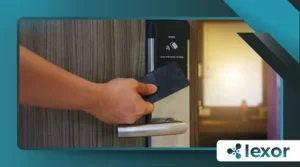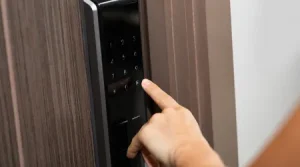How Smart Locks Work and Are They Safe?

The digital revolution has transformed home security, and how smart locks work is at the forefront of this evolution.
No longer just mechanical devices, these advanced systems blend connectivity, encryption, and convenience into a seamless user experience.
But as their adoption grows—42% of U.S. households with broadband now own at least one smart lock, according to Parks Associates—so do concerns about their safety.
Are they truly secure, or just another vulnerability in an increasingly connected world?
This deep dive explores the mechanics, benefits, risks, and real-world applications of smart locks, helping you decide whether they’re the right choice for your home.
The Mechanics Behind Smart Locks: How Do They Actually Function?
Unlike traditional deadbolts, smart locks eliminate the need for physical keys by leveraging wireless technology.
They communicate via Bluetooth, Wi-Fi, Zigbee, or Z-Wave, syncing with smartphones, key fobs, or voice assistants like Alexa and Google Home.
Some high-end models, such as the Ultraloq U-Bolt Pro, even incorporate biometric authentication, allowing fingerprint or facial recognition for entry.
++What Is Tokenization and Why It Matters
This multi-layered approach ensures that even if one method fails, backup options remain available.
The Role of Encryption in Smart Lock Security
A critical aspect of how smart locks work is encryption. When you unlock your door via an app, the signal isn’t just a simple “open” command.
Instead, it’s an encrypted message that changes with each use, a technique known as rolling-code encryption.
This prevents hackers from intercepting and replaying the signal—a common attack on older wireless systems.
Brands like Level Lock take this further with AES-256 encryption, the same standard used by banks and governments.
++How to Set Up a Smart Home on a Budget
Power Sources: Batteries, Hardwiring, and Fail-Safes
One common concern is what happens if a smart lock’s battery dies.
Most models, like the August Wi-Fi Smart Lock, provide low-battery warnings weeks in advance and allow manual override via a physical key or external power pack.
Hardwired smart locks, such as those integrated into full smart home systems, avoid this issue entirely but require professional installation.
++Automating Your Morning Routine with Smart Tech
Either way, manufacturers prioritize fail-safes to ensure you’re never locked out.

Authentication Methods: Beyond the Physical Key
Gone are the days when a metal key was the only way to unlock a door. Smart locks offer multiple entry methods, each with its own security advantages.
Mobile App Control: Convenience at Your Fingertips
The most common method is smartphone access. Apps like Yale Access or Schlage Home let you lock and unlock doors remotely, grant temporary access to guests, and monitor entry logs.
But what if your phone is stolen? Reputable systems require biometric or PIN verification before granting access, ensuring thieves can’t exploit a lost device.
Biometric Entry: The Future of Keyless Security
Fingerprint and facial recognition are no longer limited to smartphones. High-security smart locks, like the Samsung SHP-DR708, use these technologies to ensure only authorized users gain entry.
While highly secure, biometrics aren’t foolproof—environmental factors like poor lighting or wet fingers can cause errors. That’s why most locks offer backup methods like PIN codes or NFC cards.
Voice and Automation Integration
For hands-free convenience, many smart locks work with Amazon Alexa, Google Assistant, and Apple HomeKit. You can say, “Alexa, lock the front door,” and it happens instantly.
However, voice commands alone are rarely enough for security. Most systems require additional verification, such as a spoken PIN, to prevent unauthorized access.
Security Risks: Are Smart Locks Easier to Hack?
No security system is perfect, and smart locks introduce unique vulnerabilities alongside their benefits. Understanding these risks helps you make an informed decision.
Bluetooth and Wi-Fi Vulnerabilities
Cheaper smart locks sometimes use unencrypted Bluetooth signals, making them susceptible to relay attacks.
In 2023, Pen Test Partners demonstrated how hackers could amplify a weak Bluetooth signal to unlock doors from a distance.
Premium brands counter this with time-bound authentication, where access codes expire within seconds, leaving no window for exploitation.
Cloud-Based vs. Local-Only Systems
Cloud-connected locks, like those from August and Yale, allow remote access but depend on server security. If the manufacturer’s servers are breached, hackers could theoretically gain control.
Local-only systems, such as the Level Lock+, operate entirely offline, eliminating this risk but sacrificing remote features. Your choice depends on whether convenience or absolute security matters more.
Physical Tampering: Are Smart Locks Pick-Proof?
While digital threats get attention, physical attacks remain a concern. Some smart locks, like the Kwikset Halo, feature anti-pick and anti-bump mechanisms, making them as resistant as high-end traditional locks.
However, others prioritize sleek design over durability. Always check ANSI Grade certifications—Grade 1 being the highest—before purchasing.
Real-World Applications: When Do Smart Locks Shine?
Smart locks aren’t just for tech enthusiasts. They solve real problems for homeowners, renters, and businesses alike.
For Frequent Travelers and Airbnb Hosts
Imagine you’re abroad and a friend needs to check your house. Instead of hiding a key, you grant temporary access via an app.
Services like RemoteLock specialize in this, offering customizable entry schedules.
For Families and Shared Spaces
Lost keys are a headache, especially with kids. Smart locks eliminate this issue—teenagers can use their phones, and parents receive notifications when they come home.
For High-Security Needs
While no lock is 100% unhackable, premium smart locks offer better protection than most traditional ones.
Features like real-time alerts, auto-locking, and geofencing ensure your door is never left unlocked by mistake.
Read more: Parks Associates Smart Home Research
Final Verdict: Should You Switch to a Smart Lock?
Understanding how smart locks work reveals both their strengths and limitations. They’re not just gadgets—they’re evolving security solutions that adapt to modern threats.
If you prioritize convenience, remote access, and advanced features, a smart lock is a worthwhile upgrade. But if absolute physical security is your top concern, a high-grade traditional deadbolt might still be preferable.
The future of home security is undeniably digital. The question is—are you ready to embrace it?
Frequently Asked Questions (FAQs)
1. Can smart locks be hacked?
Yes, but only if they use weak encryption or outdated firmware. Premium models with rolling codes and AES-256 encryption are extremely difficult to breach.
2. Do smart locks work during a power outage?
Most run on batteries, so they remain functional. Hardwired models may require backup power, but all reputable brands include manual override options.
3. Are smart locks compatible with existing doors?
Many, like the August Wi-Fi Smart Lock, retrofit onto standard deadbolts without replacing the entire mechanism. Always check compatibility before purchasing.
4. How long do smart lock batteries last?
Typically 6-12 months, depending on usage. Most notify you via app when batteries are low.
5. Can I still use a physical key with a smart lock?
Some models, like the Yale Assure Lock 2, allow keyed entry as a backup. Others, like the Level Lock+, are completely keyless.
